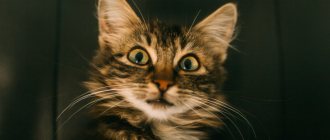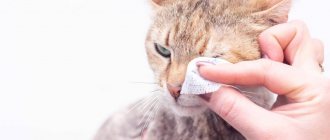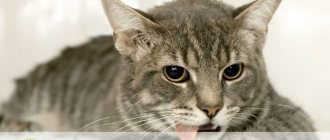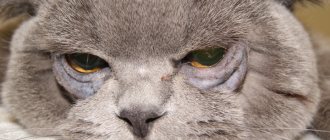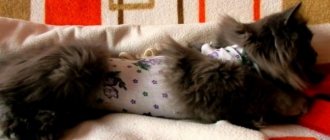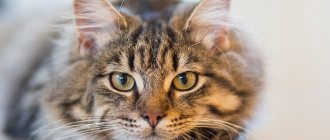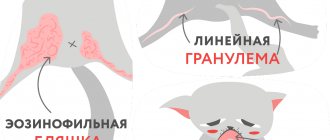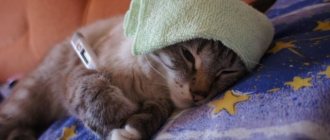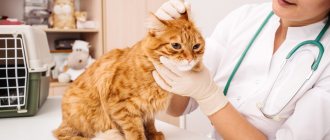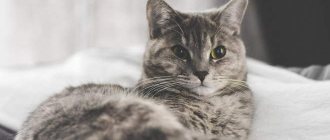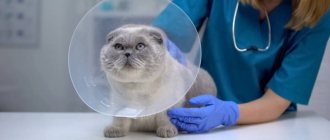Animals, like people, are not immune from serious illnesses. There are ailments, the positive outcome of which depends on how quickly the cat or dog is taken to the veterinary clinic. The most important thing is not to waste precious time. Volvulus in cats is one such disease. Large dogs weighing more than 25 kg are more susceptible to it. Cats get sick much less often. But this does not mean that there is no danger of getting sick for them.
What is the disease
Intestinal volvulus is the twisting of the intestinal loop around the mesenteric axis or the rotation of one of its sections relative to another. It entails the closure of the intestinal lumen. Large arteries are compressed, resulting in disruption of nutrition and blood supply to the intestinal wall. Intestinal obstruction forms, the bloodless tissues gradually necrotize (die). If urgent measures are not taken, the pathological process will be complicated by sepsis and peritonitis. It will be impossible to save the animal.
In cats, the disease has three development options:
- volvulus of the small intestine (a significant part of the intestine located between the stomach and large intestine);
- volvulus of the colon and cecum;
- eversion of part of one intestine into the lumen of another (intussusception).
Causes of volvulus and risk factors
For a turnaround to occur, atypical, force majeure circumstances must arise. These may be internal and external reasons:
- physical: abdominal injury, impact with water, sharp turn of the body, forced unusual position, compression, concussion, lifting heavy objects;
- food: overeating, especially after a long fast, eating unfamiliar exotic foods, large amounts of indigestible fiber in the diet, prolonged hunger;
- organic: adhesions, umbilical hernia, neoplasms, disruption of intestinal innervation due to damage to the central nervous system, pregnancy;
- chemical: lead or drug poisoning.
When analyzing patient data, factors were identified that increase the likelihood of intestinal torsion:
- age over 55 years (volvulus of the sigmoid colon often occurs in patients over 60 years of age, colon and cecum volvulus - after 50 years);
- regular constipation or diarrhea;
- sedentary lifestyle;
- hard physical labor;
- fanatical adherence to various fasting systems for weight loss, irregular nutrition;
- overeating, especially before bed.
Causes of the disease
Experts believe that the main causes of the disease are congenital anomalies in the development of the intestine, mesentery (the ligament with which the hollow organs of the abdominal cavity are fixed to its wall) and the adhesive process in the intestine.
The onset of the pathological process can be provoked by several factors. They are, as it were, secondary causes of the disease:
- a sharp change in intra-abdominal pressure that occurs during significant physical activity (running, outdoor games) on a full stomach;
- improper diet, in which prolonged hunger is replaced by heavy feedings, sharply increasing intestinal motility;
- entry of a foreign body into the kitten’s intestines due to accidental ingestion;
- use of low quality feed;
- long-term bowel dysfunction (constipation);
- tumor diseases of the gastrointestinal tract.
The risk group usually includes kittens that are not yet one year old. But even an adult animal can develop intestinal pathology if one or more risk factors are present.
Volvulus and twisting of the intestines in animals
Volvulus and torsion of the intestine in animals (Torsio et volvulus intestinorum) is a rapid closure of the intestinal lumen by turning it along the longitudinal axis or by constriction with other intestinal loops. In animals, it is customary to distinguish between intestinal volvulus, entanglement, twisting of loops around the mesentery, and nodulation. In horses, wrapping occurs mainly of the left knees of the large colon, and much less often the right knees - the cecum and small colon. In animals, twisting, tangling and knotting often occur with complete closure of the lumen of the small intestine. In cattle and pigs, volvulus and torsion are rare.
Etiology . The cause of volvulus and twisting of the intestines in animals is a sharp change in intra-abdominal pressure during jumps, a sudden stop, with strong draft stress, sharp turns, especially when the animal rolls and rolls over. Torsion and volvulus of the intestines in animals is facilitated by the existing flatulence of individual intestinal loops, chymostasis or coprostasis, intestinal stones, enteralgia and enteritis, fibrous adhesions of intestinal loops, neoplasms, etc. In dogs, the cause of intestinal volvulus can be heavy one-time feeding, various stressful situations, as well as heavy physical activity and games immediately after eating food. Feeding dogs low-quality and unbalanced food and gastrointestinal diseases contribute to bloat.
Pathogenesis . The development of the pathological process during volvulus and torsion of the intestines is similar to the pathogenesis of internal strangulation of the intestines. The leading factors in the development of the pathological process in this disease are constant pain impulses, intoxication and dehydration of the body.
Pathological changes . During a pathological autopsy of a dead animal, at the site of volvulus we find a sharp contraction of the intestine, the intestinal wall is externally anemic, and in some dead animals there is severe necrosis. From the site of the volvulus, the obstructed part of the intestine is greatly distended with gases, the serous membrane has a dark red color; the intestinal wall is thickened and infiltrated, the veins are heavily engorged with blood; the mucous membrane is dark red, with folds, loose, in places we find necrosis of the mucous membrane. The internal contents of the intestine are liquid and bloody.
If there is torsion and nodulation of the small intestine, then its proximal part, above the site of obstruction, is greatly distended with gases and chyme of a watery consistency. At the site of intestinal twisting, we find the same changes as during volvulus. With all types of volvulus and twisting of the intestine, we find up to 5-10 liters of cherry or dark red transudate in the abdominal cavity, and with a rupture of the intestine - feed particles and inflammation of the peritoneum.
Clinical picture . The disease in animals begins with mild anxiety: the animal looks at its stomach, constantly moves, tries to lie down, and rolls on the ground.
Due to the development of edema in the compressed area of the intestine and the appearance of flatulence, the animal’s pain increases sharply. Due to the pain that appears, the animal falls to the ground, begins to wallow, lies on its back with outstretched limbs, and assumes the pose of a sitting dog. The body temperature of a sick animal often rises to 39-39.5 C; by the end of the illness, the temperature drops to normal. The mucous membrane of the conjunctiva is very red.
If an animal experiences obstruction of the small intestines, the heart rate increases to 70-100 beats per minute. A sick animal loses its appetite. If an animal has a volvulus of the large colon, then during a clinical examination we note a slight enlargement of the abdomen. When auscultating the intestines, intestinal peristalsis is uneven, accompanied by periodic ringing noises; at the end of the disease, peristalsis completely disappears. The animal develops intestinal flatulence. Acts of defecation stop.
If a sick animal has complete obstruction of the small intestine, then it will show signs of secondary expansion of the stomach. When examining gastric contents, it has a yellow-brown color, low acidity and an unpleasant putrefactive odor. The reaction to bile pigments and lactic acid is positive. When examining blood, we note pleiochromia and erythrocytosis, neutrophilia. By the end of the disease there is relative lymphocytosis, ESR is very slow. With a test puncture of the lower wall of the abdomen, we obtain an effusion, which at the beginning of the disease is yellowish and opalescent, later reddish and contains red blood cells and leukocytes. When performing fluoroscopy of the intestinal area, it is sometimes possible to establish limited intestinal flatulence.
In dogs, the clinical picture of the disease is manifested by sudden and severe bloating of the abdomen, breathing becomes heavy, vomiting appears with foam, which sometimes contains blood. On clinical examination, the visible mucous membranes are pale. In a sick dog, we note a frequent urge to defecate, in the absence of feces.
A veterinarian makes a diagnosis A rectal examination is decisive in making a diagnosis. When the small intestine and mesentery are twisted in a sick animal, by rectal examination the veterinarian finds highly swollen loops of these intestines; There is no flatulence in other parts of the intestine. In places as far as the veterinarian’s hand can reach, upon rectal palpation, we find the laced part of the loop; the swollen intestine turns into a dense, very painful cord or knot.
When there is torsion of the left knee of the large colon, the veterinarian finds it distended, and the gastric dilatation is relatively collapsed. When the intestine is rotated 90 degrees along the axis, the pelvic bend takes a horizontal position, the upper and lower knees lie on the same horizontal plane. If the knee with shadows and pockets is located next to the left abdominal wall, then the rotation is right-sided; its location closer to the median plane indicates a left-hand turn. When turning right or left 180 degrees, the upper knee is located under the lower one. When turning 360 degrees, the knee of the pelvic bend takes close to the normal position, but the movement of the shadows becomes spiral-shaped. Volvulus of the body of the cecum is determined by severe swelling of its bottom, increased tension, pain and the spiral course of the shadows. Volvulus and torsion of the small colon are detected by palpation through the rectum. In this case, there is a narrowing of the place of volvulus, pain in the intestinal wall, which is gathered into a fold. The volvulus of the small intestine around the root of the mesentery is palpable at the level of the left kidney with a painful folded cord stretching to the left and right, under which lie swollen loops of the small intestine. In cattle, volvulus and twisting of the intestines in the area accessible to palpation are also detected through the rectum in the right half of the abdominal cavity.
Course and prognosis. Horses with obstruction of the small intestines die within 24 hours; ruminants and other animals survive up to two days; with obstruction of the large intestines, the disease lasts 2-4 days.
Treatment . Treatment of sick animals begins with pain relief. For this purpose, sick animals are injected intravenously with chloral hydrate, alcohol or analgin. In order to improve the condition of a sick animal, its contents are removed by probing the stomach during expansion. In order to prevent fermentation-putrefaction processes and the development of intestinal flatulence, anti-fermentation agents are given to the sick animal internally. The resulting gas from the intestines is removed by puncture. However, for all forms of volvulus and torsion of the intestine, the radical treatment method is surgical - laparotomy. Surgical intervention is especially indicated in ruminants and small animals, and as early as possible. In order to reduce intoxication, dehydration of the body and improve blood circulation, 5-10% solutions of sodium chloride (250-500 ml) with glucose and caffeine are administered intravenously to a sick animal. To improve blood circulation, strophanthus tincture and other remedies are prescribed.
Prevention of the disease consists of compliance with the rules of operation, maintenance, and organization of adequate feeding. Owners must feed their dogs at least twice a day; the feeding ration must be easily digestible and of good quality. It is forbidden to take the dog for a walk immediately after feeding; the dog must be given rest.
Symptoms
Volvulus in a cat has a variety of symptoms, which are especially pronounced if the small intestine is involved in the process. The animal begins to suffer from acute cramping pain. It cannot tell the owner about them, but makes it clear that it is uncomfortable. It worries, pays attention to the stomach, tries to lie down and curl up into a ball. Intestinal peristalsis, which increased at the onset of the disease, is replaced by a sharp weakening (paresis). As the disease progresses, other symptoms appear:
- bloating and asymmetry of various parts of the abdomen;
- increasing vomiting of eaten food;
- dehydration of the body, “drying out” of the body;
- a significant increase in general temperature;
- lack of stool for several days;
- increasing weakness, pallor of the mucous membranes;
- shock and loss of consciousness.
Volvulus of any part of the large intestine is less common and is characterized by more mild symptoms. But in any case, if the patient is not provided with medical assistance in a timely manner, the outcome of the disease will be unfavorable.
Diet
First, after surgery, complete fasting is established for 24 hours, with intravenous glucose. Sometimes, with extensive intestinal removal, parenteral feeding is required for several days.
The cat is then placed on a nasogastric tube or latex tube, which feeds food directly into the stomach.
Afterwards, liquid food should be introduced - vegetable purees and cereals with water, then meat purees and dairy products are gradually introduced. Then you can switch to soft food; in the first months after surgery, the cat can be fed baby food.
Feed should be fractional, in small portions, gradually increasing the amount of food per day to the normal weight.
The main problem after surgery is “short” bowel syndrome; the absorption surface decreases, which causes diarrhea and malabsorption syndrome.
Drug therapy
Infusion therapy must be prescribed to relieve the state of shock and normalize the water-salt balance. Usually saline solutions, Ringer-Locke solution, etc. are used.
A course of antibiotics is used to prevent postoperative complications and prevent the development of an infectious process. It is also necessary to prescribe prednisone, it provides relief from shock and prevents the development of adhesions.
For pain relief use baralgin or dalargin.
Enzyme support should be prescribed - Essentiale, Panzinorm.
Intramuscular administration of vitamin B12 is used as rehabilitation.
Diagnostics
Only a veterinarian can diagnose volvulus. After conducting a clinical examination of the animal, he can already make a preliminary diagnosis. Plain radiography, the main and most accurate method for diagnosing this disease, will help clarify it. The x-ray clearly shows pathological changes, areas of enlarged intestinal loops, supplemented by a clear sign - intestinal obstruction. Auxiliary diagnostic methods will help clarify the picture of the disease:
- Ultrasound of the abdominal cavity;
- bacteriological analysis of vomit;
- laboratory blood test.
The purpose of these diagnostic measures is to differentiate the original disease from other conditions similar to it:
- tumor and inflammatory diseases of the gastrointestinal tract;
- adhesive disease;
- renal colic.
Symptomatic manifestations
Symptoms of intestinal obstruction are pronounced and in cats can be as follows:
The animal's mood changes dramatically. Some owners note apathy, a desire to hide from people and other pets
In another case, the cat will try in every possible way to attract attention to itself: meow loudly, follow behind, show its belly. Any changes in the cat’s usual behavior are an alarming symptom. Pet refuses to eat
At first, the amount of food consumed becomes less, then a complete refusal of food occurs. With partial intestinal obstruction, cats begin vomiting after eating. This symptom indicates that only a small amount of food was able to move through the intestines. The remaining food causes unbearable stomach pain in the animal, so the pet reflexively burps. No bowel movement. This symptom of intestinal obstruction in cats cannot always be considered reliable in individuals who often walk outside. In this case, it is almost impossible for the owners to track where exactly the cat emptied its bowels. Pets are another matter. A prolonged absence of feces in the tray can be a sign of either ordinary constipation or intussusception in a cat or kitten. Aggression when attempting to inspect. If the owner tries to feel the pet's belly, the cat is likely to bite or scratch. This is due to the fact that the animal experiences severe pain, and touching only aggravates the situation. If the cat allows itself to be examined, the owner will notice tension in the walls of the abdominal cavity, and sometimes he will be able to feel a foreign object or a hard area in the intestine. It is better not to carry out an examination unless absolutely necessary, since a careless movement can harm your pet. Abdominal enlargement. Since the gases accumulating in the intestines have no outlet, the pet’s abdominal cavity begins to increase in size. You may notice that the cat is rolling on the floor and actively licking its belly.
https://youtube.com/watch?v=GqSr5mHZ5ac
If an animal exhibits at least one of the symptoms described above, this may indicate intestinal obstruction in cats. The best decision that the owner of a sick pet will make is to immediately show it to the veterinarian, since trying to give a laxative, warming up or massage will only bring harm.
Treatment and rehabilitation
The disease is treated exclusively surgically - laparotomy. Preparation for surgery should be urgent, since the cat’s condition can rapidly deteriorate. The count of time when an animal can be saved is counted in minutes.
The operation includes the following tasks:
- straightening of torsion of intestinal loops;
- viewing sections of the intestine and segmental resection of that part in which necrotic changes began;
- An ileostomy (extraction of the small intestine onto the anterior abdominal wall for the outflow of pus and inflammatory exudate) is necessary in the presence of peritonitis.
Even if medical care is provided in a timely manner, the outcome of the disease can lead to disability of the animal. After resection of part of the intestine, its functions may be impaired. Therefore, the operated animal will require constant attention and proper care from the owner.
After the operation, it is recommended to leave the cat in the clinic for several days for medical observation. Rehabilitation therapy lasts several months and takes place on an outpatient basis. Restorative treatment should provide comprehensive support to the body:
- antibiotic therapy is aimed at avoiding severe inflammatory complications of the postoperative wound;
- taking painkillers will help relieve severe pain (Baralgin);
- the administration of probiotics is intended to restore damaged intestinal microflora (“Essentiale”);
- infusion of saline solutions is necessary to restore water-salt balance and rehydrate (treat dehydration) of the body;
- a gentle diet is needed to protect the gastrointestinal tract from unnecessary stress.
A very important condition for successful recovery after surgery is compliance with the rules of asepsis and antisepsis when caring for the animal. The addition of any infection during this period can be fatal for him.
Treatment of intestinal obstruction in cats
As a result of establishing the cause, further actions can be judged: either conservative therapeutic treatment of the sick animal is carried out, or emergency surgery is performed to eliminate the cause of blockage of the intestinal lumen (if a foreign body, hernia, tumor, etc. is detected).
Surgery is also necessary if symptoms persist or worsen, or if signs of peritonitis are noted.
In all cases, special attention should be paid to stabilizing the animal and restoring fluid and electrolyte balance after surgery
Prevention
Good prevention of all diseases of the gastrointestinal tract of domestic animals is the careful implementation of the conditions for keeping them:
- feed the cat several times a day in small portions;
- immediately after feeding, do not allow your pet to run and frolic for a while;
- use only high-quality, easily digestible feed for feeding;
- ensure that the animal always has free access to clean water;
- protect your pet from unnecessary worries, stress and negative emotions;
- carry out timely treatment of inflammatory diseases of the stomach and intestines.
Volvulus is a serious illness that is difficult to treat. It is much easier to prevent it from starting than to later take emergency and painful measures to save the animal.
Symptoms
Among the first symptoms of volvulus are cramping pain of varying intensity that increases over time, nausea and vomiting. After some time, the reflux of feces into the stomach develops and the vomit acquires a characteristic odor. The patient passes gas, but does not have stool. Intestinal motility does not disappear at the onset of the disease, and peristalsis can be seen through the abdominal wall. The abdomen takes on an asymmetrical shape, and bloating rapidly increases. During the medical examination, other symptoms of intestinal volvulus become obvious: tachycardia, drop in blood pressure, increase in body temperature (with the formation of intestinal necrosis or peritonitis), dry mouth, during fluoroscopy, intestinal loops swollen with gas or accumulated fluid (Kloiber cups) are noticeable ). During palpation, abdominal bloating, local compaction or abnormal softness of certain areas of the abdomen, pain are noted, and characteristic dripping sounds can be heard on auscalation.
